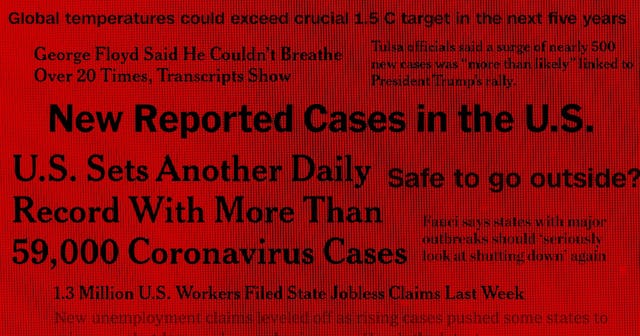I'm Addicted To 'Doomscrolling,' But It Gives Me A Sense of Control

Since March, I’ve been consuming news in almost scary amounts. Then, the breaking news alerts were fast and furious and I hadn’t finished reading one article before the next flashed across my phone. That first Sunday, when Apple told me how many hours I’d spent on my phone, I cringed. Certainly it can’t be healthy to spend that much time staring at my phone, reading about how the world outside my home is falling apart, piece by piece. And yet, I persisted.
Because four months later, I’m still reading, and lately, the breaking news alerts aren’t fast enough for how fast I’m consuming the news. I’ve also added a morning numbers check. Every morning I wake up and press refresh on the websites that track the number of positive COVID-19 tests in my town and my state. I refresh to see how many new deaths were added to the already too high number from the day before. I look to see whether the hospitalizations have decreased or increased and whether more or less ICU beds have become available. Then I move to the news and read every word of every article that is no doubt pointing to the end of the world. (As an avid dystopian fiction reader, I believe I have a particular skill set when it comes to spotting end-of-the-world themes.)
In summary: I am doomsurfing. Or, more accurately, doomscrolling, because I prefer to read my end-of-the-world content on my mobile device.
And I have been doomscrolling every day for four months.
And woah, is it exhausting.
I first stumbled upon the word “doomscrolling” in an article in wired.com — yes, it popped up on my phone as a news alert and I read it instantly. The New York Times’ Kevin Roose described doomsurfing, or doomscrolling, as “falling into deep, morbid rabbit holes filled with coronavirus content, agitating myself to the point of physical discomfort, erasing any hope of a good night’s sleep.” Also, “an endless scroll through social media in a desperate search for clarity.”
I then learned doomscrolling is so common that Merriam-Webster included doomsurfing and doomscrolling in their “Words We’re Watching” and defined it as such: “Doomscrolling and doomsurfing are new terms referring to the tendency to continue to surf or scroll through bad news, even though that news is saddening, disheartening, or depressing. Many people are finding themselves reading continuously bad news about COVID-19 without the ability to stop or step back.” Dictionary.com added doomscrolling to its list of New Words We Created Because of Coronavirus (along with other pandemic life defining words like covidiot and quarantini).
There is no question doomscrolling is bad for you in so many ways. All this scary news consumption is taking a toll on my anxiety levels, my sleep, my time management—too many things are falling by the wayside as I read article after article, and I’m losing so many precious hours to a tiny handheld device on my screen. I know the experts say to limit news consumption. I know the experts say to disconnect—I’ve even interviewed some of those experts who say it’s important to disconnect and during each interview, I’ve nodded along and vowed to try and I’ve broken each and every vow about three minutes after the interview ended.
But I have a few good reasons for doomscrolling.
One: because I’m wholly and completely addicted to my phone more than ever and probably need a technology intervention. My usage has gone down significantly since those first weeks in March, but the number of hours I’m staring at my phone screen is still significantly higher than it had been in February.
And two, and arguably more relevantly, doomscrolling makes me feel in control because it turns something vague and terrifying and invisible into something quantifiable, particularly my early morning state and local number study. Doomscrolling turns something intangible into something I can whittle down into numbers and statistics and facts.
I’ve dealt with scary, invisible diseases before. I’ve dealt with intangible, unseen monsters that infect the people you care the most about and turn your life upside down, and I learned then, that there’s value in information and channeling something that feels too big to even wrap your arms around into very digestible facts and statistics. I learned years ago that information, being armed with facts and statistics and every single word written about a particular subject, makes it easier to believe the world isn’t as unpredictable and terrifying as it sometimes seems.
The truth is: in a very ironic twist, doomscrolling, reading about all the ways the world is falling apart, makes me think I can somehow keep my world together. Because knowledge is power. Maybe because it means I’ll be prepared, or, at the very least, not completely caught off guard if the worst happens. Maybe because invisible monsters aren’t so scary when they’re reduced to charts and graphs and words on a screen.
Make no mistake. Doomscrolling is trouble. My anxiety is higher, my sleep is less quality, my productivity is often laughable. But I know that when it comes to uncertainty, I need to doomscroll. I need to quantify that invisible monster that’s too big, because I need the feeling of control, even if it’s nothing but the illusion of control.
There must be some happy medium, some way to get that space to breathe and extra mental bandwidth, while also finding a way to wrest some control from a world that constantly feels completely out of control. And hopefully, I’ll find it. Or the world will stop falling apart.
This article was originally published on